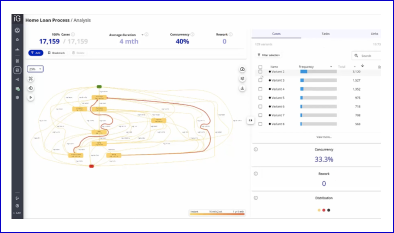Process automation has come a long way over the last two or three decades.
We’ve evolved away from a classical definition of business process management (BPM), which largely consisted of rote, single-threaded sequences of steps, interrupted by decisioning activities, where a human domain expert steps in to make a selection or handoff that hopefully keeps the process execution moving forward.
Decisioning in this context is a human act that happens in the midst of an ongoing process, as opposed to a pre-process policy-setting activity, or a post-event analysis and adjustment exercise.
Today, any mid-to-large-sized company will have thousands of complex business processes in flight at any given time, such as order-to-cash, manufacturing and delivery, incident reporting, system upgrades, facility management, and so on. These capabilities now fall under the categorization of DPA (digital process automation) or CPO (continuous process orchestration), depending upon which analyst you talk to in a given month.
DPA and process orchestration software can power BPM to make some of its own intelligent automated decisions, faster than any human, within multiple processes, aided by an exponential increase in scalable compute and storage resources.
With these powerful systems in place serving up automated processes at such high volumes, maybe a human stepping in to decide is an activity that no longer adds value.
Perhaps the art of human decisioning is dying out, much like sculpting. After all, who needs a great artist like Donatello or Rodin to carefully chisel out an emotive character from solid rock, when we have 3D printers?
Putting on siloed process blinders
We’ve abstracted many of our choices to a higher ‘strategic’ level, by aggregating processes in much larger quantities, then viewing and managing their progress within role-specific dashboards and analytics silos, to support things like ‘goal setting’ and ‘strategic tradeoffs.’
Even if we’ve lost sight of decisioning due to automation, we never stopped making decisions. Humans will still need to react to changes and alerts that pop out of these process silos.
A CRO or sales director may spend all day inside Salesforce or Manhattan software, watching lead deal progress and tracking order fulfillment. A CFO or controller spends all day inside SAP, looking at orders and transactions. And, a CIO or IT leader monitors the development and release pipeline, or an ITSM platform for alerts about the health of all systems in the org’s estate.
Advanced business process automation should fill in most gaps in these processes. Who cares if different teams are looking at their own stovepipe dashboards, if that’s how it has always been?
Why cross-functional awareness is critical
Take for instance a sales VP at an industrial equipment vendor who is looking to boost orders to meet a quarterly goal.
She could go into her dashboard, run an analysis of the potential customer demand based on mined sales process data at different price points, and then roll out a new policy of real-time pricing and guaranteed free 2-week delivery times to the sales quoting tool on the next weekly team call, with incentives to match.
But what happens if the company doesn’t have enough of a certain part in its warehouse to finish the final assembly? What if the partner who makes that part is already at capacity, and can’t afford to send more? And what if the company’s logistics network is already running behind, but only in certain regions?
Sales people, driven by bonus incentives and the fact that time kills all deals, will go off and decide to sell the new offer anyway. To meet on-the-spot promises to customers, the firm eats the increased cost of expedited shipping and special part orders.
Without cross-functional awareness, that sales VP, and many of her regional sales managers, made offers customers couldn’t refuse, and the company couldn’t afford.
What if, instead of trusting our guts, we could get all the information we needed presented to us, from across all internal and partner systems in our extended enterprise, to make the best possible decision at any time?
Two classics in one modern form: automated decisioning
Modern automated decisioning brings together the best aspects of classical business process automation with situational human decisioning.
Instead of assuming that automation could entirely replace the human in the loop, this practice instead supports human decisioning with cross-functional awareness, assuming that humans should always be fully equipped to choose the best path forward when complexities arise.
Though it’s only one part of a balanced automation program, many organizations feel they can only aspire to achieve automated decisioning. But it’s really not that far out of reach.
Key enablers of automated decisioning include:
- iPaaS (Integration Platform as a Service). In today’s hybrid IT world, sources of data and process-oriented systems are as heterogeneous as life itself, and many of them have outlived their creators. Fortunately, iPaaS technologies, APIs and asynchronous event-based integration standards have also come a long way. A cloud-based iPaaS that can talk to any system, data stream or service dependency and return the necessary information offers a great start.[Text Wrapping Break]
- Continuous Process Automation supports the faster flow of business processes and automates the decisions that humans don’t need to make. Newer automation systems allow leaders to set KPI goals for process improvement and quality, alongside SLOs (service level objectives) for system level performance, so that if an anomaly arises, decisioning can ‘shift left’ so the right choices can be made for earlier course correction.[Text Wrapping Break]
- Conversational AI humanizes the user experience and inputs to the system with natural language understanding (NLU) and interaction through multiple channels including talk, email, and chat. Engineers, non-technical business experts, and customers alike can simply ask for and receive necessary information that is material to the decisioning process, instead of running queries or relying on the semantics of a new language to describe their needs.[Text Wrapping Break]
- Operational AI, which can also be ‘augmented intelligence’ can help decisionmakers identify what is most pertinent for the task at hand, while filtering out irrelevant alerts and data. AI can further provide predictive models for possible options based on past and anticipated future results.
The Intellyx Take
Automated decisioning is entirely different than other aspects of process automation such as process mining or process execution, because it is human-led as opposed to programmatically led.
Augmented by intelligent tools, the best performing teams will relearn the art of decisioning, retraining skills and instincts that have largely atrophied due to a lack of pertinent, timely information from across the extended enterprise.
It’s easy for businesses to forget that decisioning must happen in everyday processes. Why put unnecessary stress on business processes, when automated decisioning can offer a much faster and more accurate result every time?
After all, even the greatest masterpieces start with a single chisel strike.
Blog contribution from Jason English, Managing Partner, Intellyx.
©2023 Intellyx LLC. Intellyx is editorially responsible for this document. No AI bots were used to generate any part of this content. At the time of writing, iGrafx is an Intellyx customer. Image source: Jesse Loughborough, flickr CC2.0 license.




